Analysis of Human Resource Management in the Global Economy
VerifiedAdded on 2019/10/31
|15
|3803
|136
Report
AI Summary
This report examines Human Resource Management (HRM) within the context of the global economy, focusing on critical theories and concepts related to organizational culture, diversity management, international performance management, and training and development. The study uses the case study of No Name Aircraft, an organization operating internationally with subsidiaries in China, Singapore, and Vietnam, to align these HRM aspects. The analysis explores organizational culture, including communication breakdowns and resistance to change. It also investigates diversity management, highlighting issues with intolerance and discrimination. Furthermore, the report assesses international performance management, including the lack of performance reviews and standardized criteria across subsidiaries. Finally, it examines the training and development practices, identifying shortcomings in expatriate training and talent management. The report uses relevant HRM theories to provide a comprehensive overview of the challenges and opportunities in global HRM.
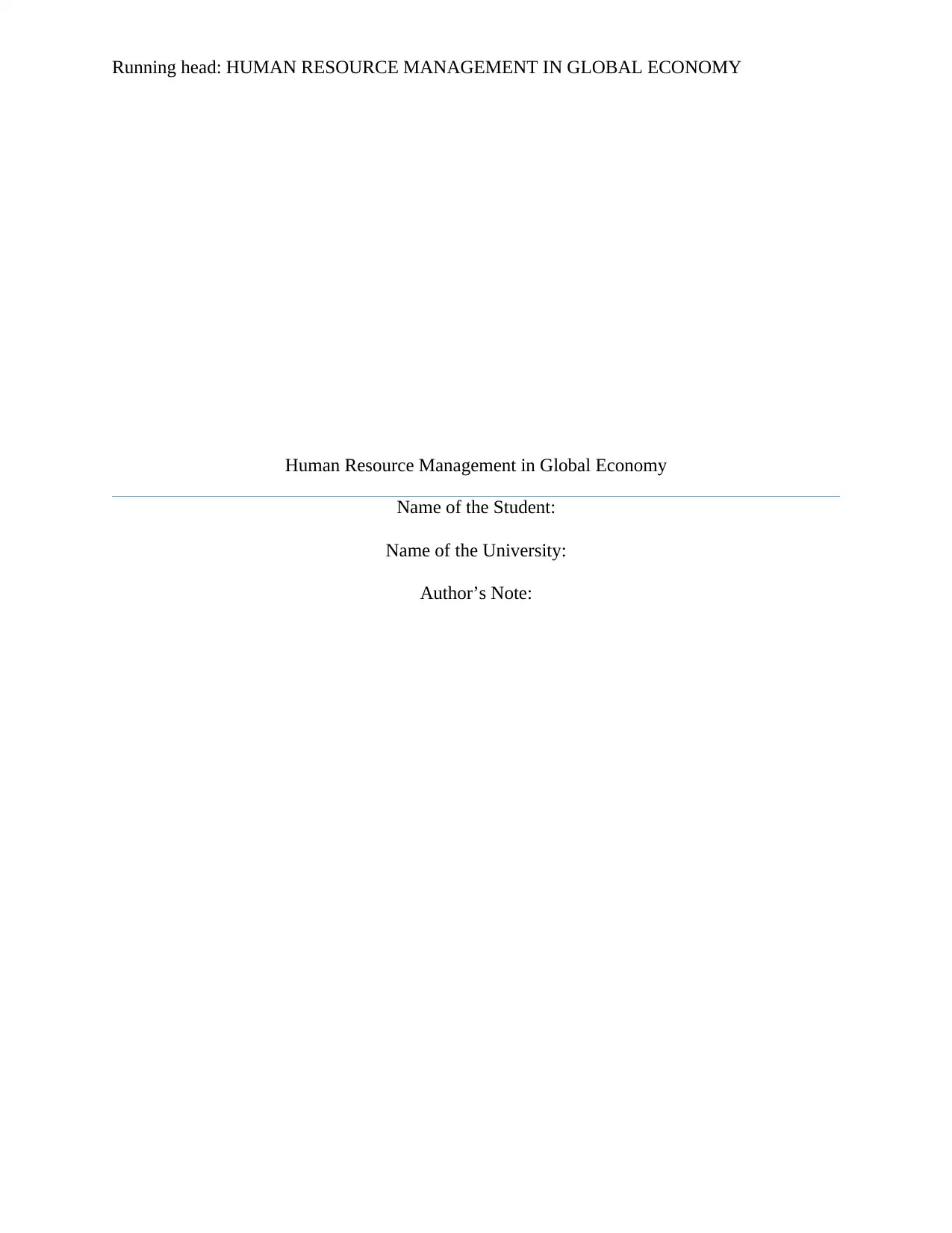
Running head: HUMAN RESOURCE MANAGEMENT IN GLOBAL ECONOMY
Human Resource Management in Global Economy
Name of the Student:
Name of the University:
Author’s Note:
Human Resource Management in Global Economy
Name of the Student:
Name of the University:
Author’s Note:
Paraphrase This Document
Need a fresh take? Get an instant paraphrase of this document with our AI Paraphraser
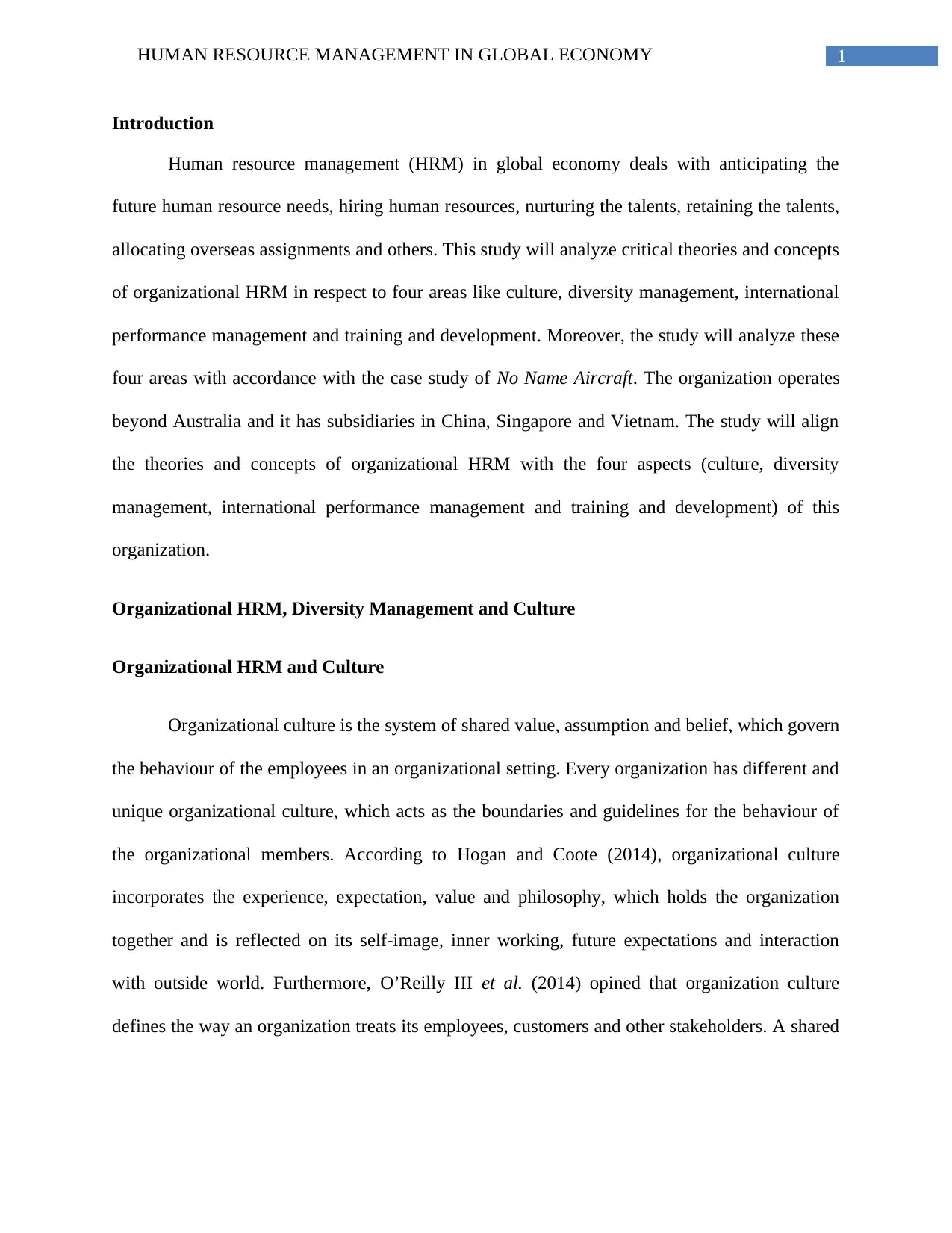
1HUMAN RESOURCE MANAGEMENT IN GLOBAL ECONOMY
Introduction
Human resource management (HRM) in global economy deals with anticipating the
future human resource needs, hiring human resources, nurturing the talents, retaining the talents,
allocating overseas assignments and others. This study will analyze critical theories and concepts
of organizational HRM in respect to four areas like culture, diversity management, international
performance management and training and development. Moreover, the study will analyze these
four areas with accordance with the case study of No Name Aircraft. The organization operates
beyond Australia and it has subsidiaries in China, Singapore and Vietnam. The study will align
the theories and concepts of organizational HRM with the four aspects (culture, diversity
management, international performance management and training and development) of this
organization.
Organizational HRM, Diversity Management and Culture
Organizational HRM and Culture
Organizational culture is the system of shared value, assumption and belief, which govern
the behaviour of the employees in an organizational setting. Every organization has different and
unique organizational culture, which acts as the boundaries and guidelines for the behaviour of
the organizational members. According to Hogan and Coote (2014), organizational culture
incorporates the experience, expectation, value and philosophy, which holds the organization
together and is reflected on its self-image, inner working, future expectations and interaction
with outside world. Furthermore, O’Reilly III et al. (2014) opined that organization culture
defines the way an organization treats its employees, customers and other stakeholders. A shared
Introduction
Human resource management (HRM) in global economy deals with anticipating the
future human resource needs, hiring human resources, nurturing the talents, retaining the talents,
allocating overseas assignments and others. This study will analyze critical theories and concepts
of organizational HRM in respect to four areas like culture, diversity management, international
performance management and training and development. Moreover, the study will analyze these
four areas with accordance with the case study of No Name Aircraft. The organization operates
beyond Australia and it has subsidiaries in China, Singapore and Vietnam. The study will align
the theories and concepts of organizational HRM with the four aspects (culture, diversity
management, international performance management and training and development) of this
organization.
Organizational HRM, Diversity Management and Culture
Organizational HRM and Culture
Organizational culture is the system of shared value, assumption and belief, which govern
the behaviour of the employees in an organizational setting. Every organization has different and
unique organizational culture, which acts as the boundaries and guidelines for the behaviour of
the organizational members. According to Hogan and Coote (2014), organizational culture
incorporates the experience, expectation, value and philosophy, which holds the organization
together and is reflected on its self-image, inner working, future expectations and interaction
with outside world. Furthermore, O’Reilly III et al. (2014) opined that organization culture
defines the way an organization treats its employees, customers and other stakeholders. A shared
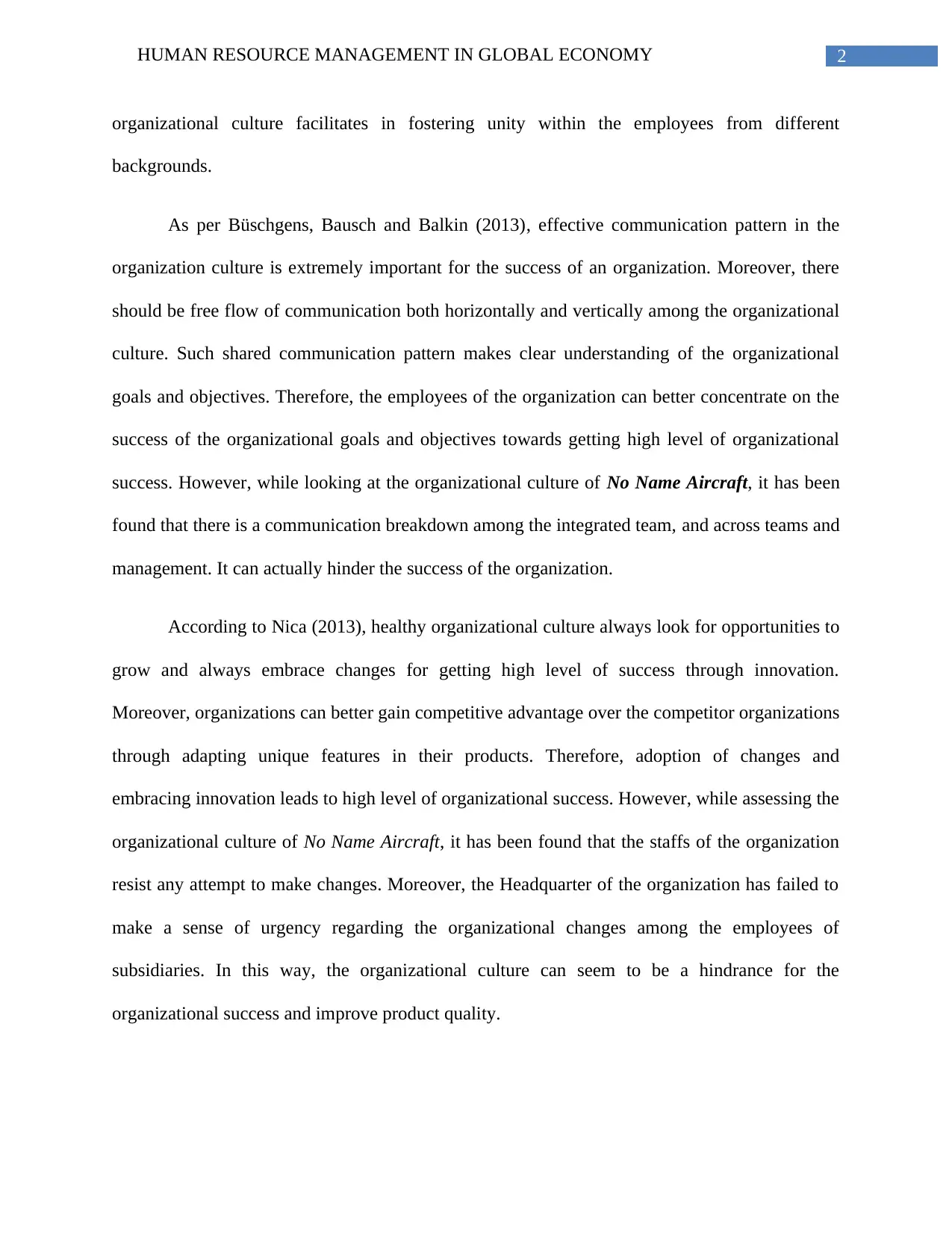
2HUMAN RESOURCE MANAGEMENT IN GLOBAL ECONOMY
organizational culture facilitates in fostering unity within the employees from different
backgrounds.
As per Büschgens, Bausch and Balkin (2013), effective communication pattern in the
organization culture is extremely important for the success of an organization. Moreover, there
should be free flow of communication both horizontally and vertically among the organizational
culture. Such shared communication pattern makes clear understanding of the organizational
goals and objectives. Therefore, the employees of the organization can better concentrate on the
success of the organizational goals and objectives towards getting high level of organizational
success. However, while looking at the organizational culture of No Name Aircraft, it has been
found that there is a communication breakdown among the integrated team, and across teams and
management. It can actually hinder the success of the organization.
According to Nica (2013), healthy organizational culture always look for opportunities to
grow and always embrace changes for getting high level of success through innovation.
Moreover, organizations can better gain competitive advantage over the competitor organizations
through adapting unique features in their products. Therefore, adoption of changes and
embracing innovation leads to high level of organizational success. However, while assessing the
organizational culture of No Name Aircraft, it has been found that the staffs of the organization
resist any attempt to make changes. Moreover, the Headquarter of the organization has failed to
make a sense of urgency regarding the organizational changes among the employees of
subsidiaries. In this way, the organizational culture can seem to be a hindrance for the
organizational success and improve product quality.
organizational culture facilitates in fostering unity within the employees from different
backgrounds.
As per Büschgens, Bausch and Balkin (2013), effective communication pattern in the
organization culture is extremely important for the success of an organization. Moreover, there
should be free flow of communication both horizontally and vertically among the organizational
culture. Such shared communication pattern makes clear understanding of the organizational
goals and objectives. Therefore, the employees of the organization can better concentrate on the
success of the organizational goals and objectives towards getting high level of organizational
success. However, while looking at the organizational culture of No Name Aircraft, it has been
found that there is a communication breakdown among the integrated team, and across teams and
management. It can actually hinder the success of the organization.
According to Nica (2013), healthy organizational culture always look for opportunities to
grow and always embrace changes for getting high level of success through innovation.
Moreover, organizations can better gain competitive advantage over the competitor organizations
through adapting unique features in their products. Therefore, adoption of changes and
embracing innovation leads to high level of organizational success. However, while assessing the
organizational culture of No Name Aircraft, it has been found that the staffs of the organization
resist any attempt to make changes. Moreover, the Headquarter of the organization has failed to
make a sense of urgency regarding the organizational changes among the employees of
subsidiaries. In this way, the organizational culture can seem to be a hindrance for the
organizational success and improve product quality.
⊘ This is a preview!⊘
Do you want full access?
Subscribe today to unlock all pages.

Trusted by 1+ million students worldwide
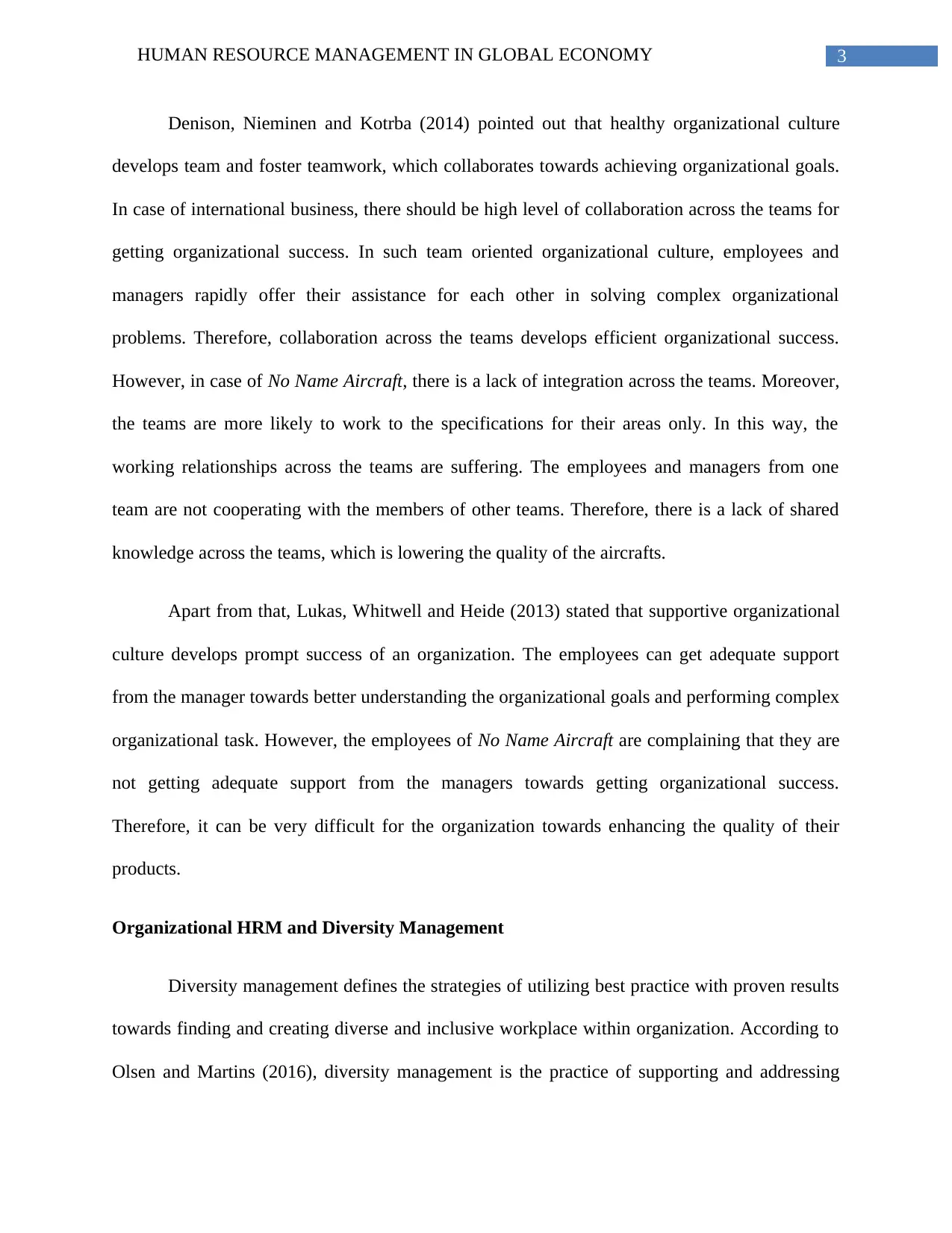
3HUMAN RESOURCE MANAGEMENT IN GLOBAL ECONOMY
Denison, Nieminen and Kotrba (2014) pointed out that healthy organizational culture
develops team and foster teamwork, which collaborates towards achieving organizational goals.
In case of international business, there should be high level of collaboration across the teams for
getting organizational success. In such team oriented organizational culture, employees and
managers rapidly offer their assistance for each other in solving complex organizational
problems. Therefore, collaboration across the teams develops efficient organizational success.
However, in case of No Name Aircraft, there is a lack of integration across the teams. Moreover,
the teams are more likely to work to the specifications for their areas only. In this way, the
working relationships across the teams are suffering. The employees and managers from one
team are not cooperating with the members of other teams. Therefore, there is a lack of shared
knowledge across the teams, which is lowering the quality of the aircrafts.
Apart from that, Lukas, Whitwell and Heide (2013) stated that supportive organizational
culture develops prompt success of an organization. The employees can get adequate support
from the manager towards better understanding the organizational goals and performing complex
organizational task. However, the employees of No Name Aircraft are complaining that they are
not getting adequate support from the managers towards getting organizational success.
Therefore, it can be very difficult for the organization towards enhancing the quality of their
products.
Organizational HRM and Diversity Management
Diversity management defines the strategies of utilizing best practice with proven results
towards finding and creating diverse and inclusive workplace within organization. According to
Olsen and Martins (2016), diversity management is the practice of supporting and addressing
Denison, Nieminen and Kotrba (2014) pointed out that healthy organizational culture
develops team and foster teamwork, which collaborates towards achieving organizational goals.
In case of international business, there should be high level of collaboration across the teams for
getting organizational success. In such team oriented organizational culture, employees and
managers rapidly offer their assistance for each other in solving complex organizational
problems. Therefore, collaboration across the teams develops efficient organizational success.
However, in case of No Name Aircraft, there is a lack of integration across the teams. Moreover,
the teams are more likely to work to the specifications for their areas only. In this way, the
working relationships across the teams are suffering. The employees and managers from one
team are not cooperating with the members of other teams. Therefore, there is a lack of shared
knowledge across the teams, which is lowering the quality of the aircrafts.
Apart from that, Lukas, Whitwell and Heide (2013) stated that supportive organizational
culture develops prompt success of an organization. The employees can get adequate support
from the manager towards better understanding the organizational goals and performing complex
organizational task. However, the employees of No Name Aircraft are complaining that they are
not getting adequate support from the managers towards getting organizational success.
Therefore, it can be very difficult for the organization towards enhancing the quality of their
products.
Organizational HRM and Diversity Management
Diversity management defines the strategies of utilizing best practice with proven results
towards finding and creating diverse and inclusive workplace within organization. According to
Olsen and Martins (2016), diversity management is the practice of supporting and addressing
Paraphrase This Document
Need a fresh take? Get an instant paraphrase of this document with our AI Paraphraser
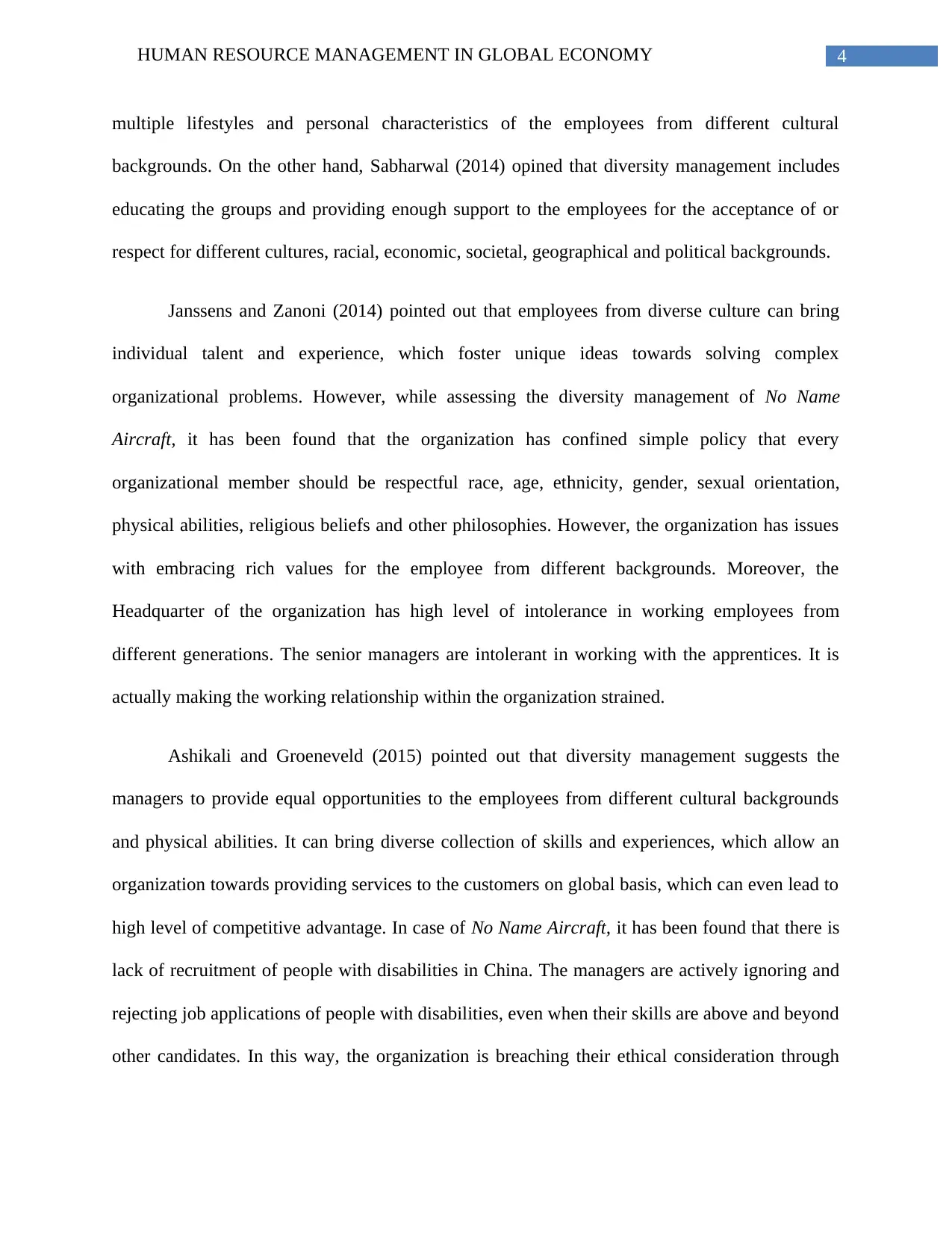
4HUMAN RESOURCE MANAGEMENT IN GLOBAL ECONOMY
multiple lifestyles and personal characteristics of the employees from different cultural
backgrounds. On the other hand, Sabharwal (2014) opined that diversity management includes
educating the groups and providing enough support to the employees for the acceptance of or
respect for different cultures, racial, economic, societal, geographical and political backgrounds.
Janssens and Zanoni (2014) pointed out that employees from diverse culture can bring
individual talent and experience, which foster unique ideas towards solving complex
organizational problems. However, while assessing the diversity management of No Name
Aircraft, it has been found that the organization has confined simple policy that every
organizational member should be respectful race, age, ethnicity, gender, sexual orientation,
physical abilities, religious beliefs and other philosophies. However, the organization has issues
with embracing rich values for the employee from different backgrounds. Moreover, the
Headquarter of the organization has high level of intolerance in working employees from
different generations. The senior managers are intolerant in working with the apprentices. It is
actually making the working relationship within the organization strained.
Ashikali and Groeneveld (2015) pointed out that diversity management suggests the
managers to provide equal opportunities to the employees from different cultural backgrounds
and physical abilities. It can bring diverse collection of skills and experiences, which allow an
organization towards providing services to the customers on global basis, which can even lead to
high level of competitive advantage. In case of No Name Aircraft, it has been found that there is
lack of recruitment of people with disabilities in China. The managers are actively ignoring and
rejecting job applications of people with disabilities, even when their skills are above and beyond
other candidates. In this way, the organization is breaching their ethical consideration through
multiple lifestyles and personal characteristics of the employees from different cultural
backgrounds. On the other hand, Sabharwal (2014) opined that diversity management includes
educating the groups and providing enough support to the employees for the acceptance of or
respect for different cultures, racial, economic, societal, geographical and political backgrounds.
Janssens and Zanoni (2014) pointed out that employees from diverse culture can bring
individual talent and experience, which foster unique ideas towards solving complex
organizational problems. However, while assessing the diversity management of No Name
Aircraft, it has been found that the organization has confined simple policy that every
organizational member should be respectful race, age, ethnicity, gender, sexual orientation,
physical abilities, religious beliefs and other philosophies. However, the organization has issues
with embracing rich values for the employee from different backgrounds. Moreover, the
Headquarter of the organization has high level of intolerance in working employees from
different generations. The senior managers are intolerant in working with the apprentices. It is
actually making the working relationship within the organization strained.
Ashikali and Groeneveld (2015) pointed out that diversity management suggests the
managers to provide equal opportunities to the employees from different cultural backgrounds
and physical abilities. It can bring diverse collection of skills and experiences, which allow an
organization towards providing services to the customers on global basis, which can even lead to
high level of competitive advantage. In case of No Name Aircraft, it has been found that there is
lack of recruitment of people with disabilities in China. The managers are actively ignoring and
rejecting job applications of people with disabilities, even when their skills are above and beyond
other candidates. In this way, the organization is breaching their ethical consideration through
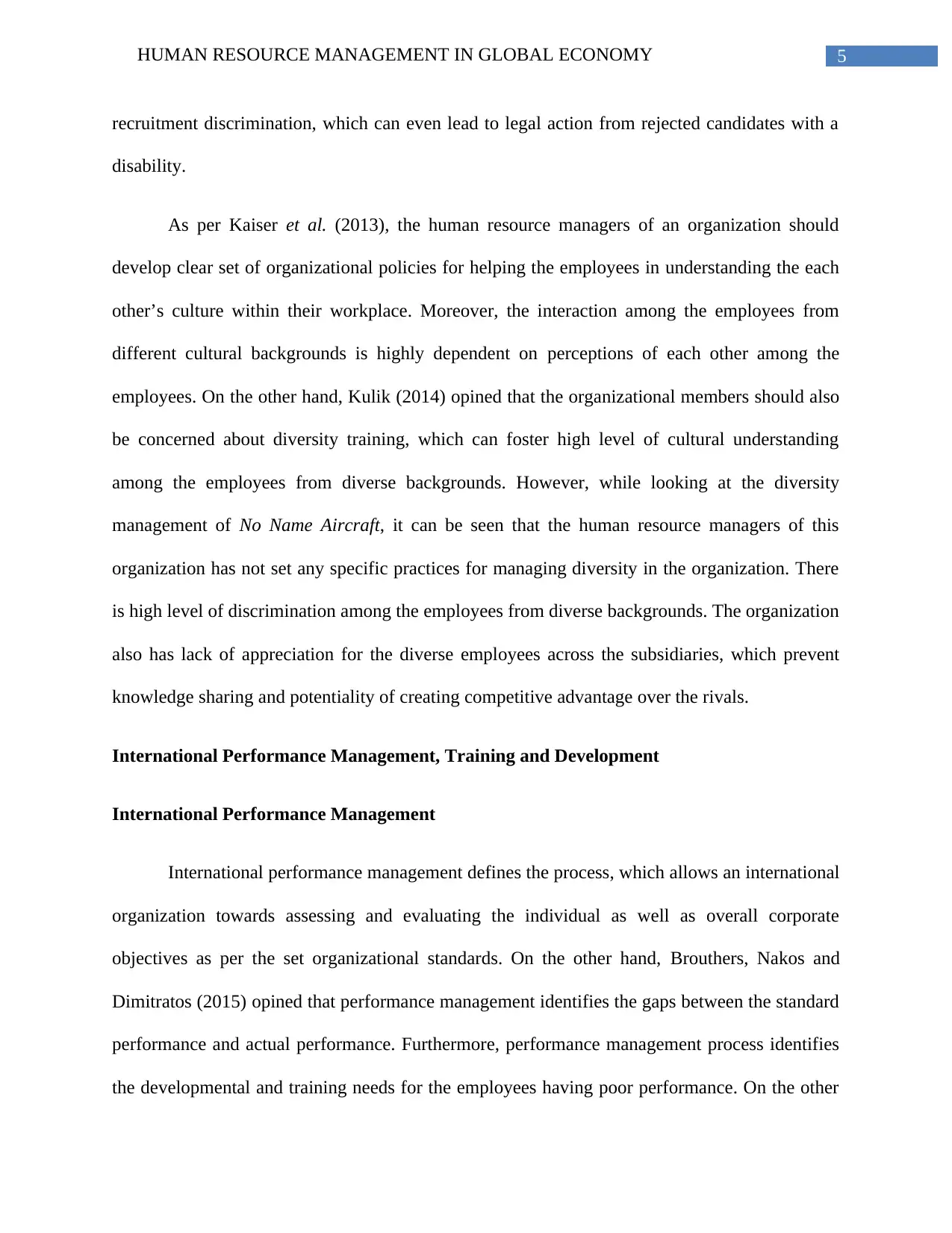
5HUMAN RESOURCE MANAGEMENT IN GLOBAL ECONOMY
recruitment discrimination, which can even lead to legal action from rejected candidates with a
disability.
As per Kaiser et al. (2013), the human resource managers of an organization should
develop clear set of organizational policies for helping the employees in understanding the each
other’s culture within their workplace. Moreover, the interaction among the employees from
different cultural backgrounds is highly dependent on perceptions of each other among the
employees. On the other hand, Kulik (2014) opined that the organizational members should also
be concerned about diversity training, which can foster high level of cultural understanding
among the employees from diverse backgrounds. However, while looking at the diversity
management of No Name Aircraft, it can be seen that the human resource managers of this
organization has not set any specific practices for managing diversity in the organization. There
is high level of discrimination among the employees from diverse backgrounds. The organization
also has lack of appreciation for the diverse employees across the subsidiaries, which prevent
knowledge sharing and potentiality of creating competitive advantage over the rivals.
International Performance Management, Training and Development
International Performance Management
International performance management defines the process, which allows an international
organization towards assessing and evaluating the individual as well as overall corporate
objectives as per the set organizational standards. On the other hand, Brouthers, Nakos and
Dimitratos (2015) opined that performance management identifies the gaps between the standard
performance and actual performance. Furthermore, performance management process identifies
the developmental and training needs for the employees having poor performance. On the other
recruitment discrimination, which can even lead to legal action from rejected candidates with a
disability.
As per Kaiser et al. (2013), the human resource managers of an organization should
develop clear set of organizational policies for helping the employees in understanding the each
other’s culture within their workplace. Moreover, the interaction among the employees from
different cultural backgrounds is highly dependent on perceptions of each other among the
employees. On the other hand, Kulik (2014) opined that the organizational members should also
be concerned about diversity training, which can foster high level of cultural understanding
among the employees from diverse backgrounds. However, while looking at the diversity
management of No Name Aircraft, it can be seen that the human resource managers of this
organization has not set any specific practices for managing diversity in the organization. There
is high level of discrimination among the employees from diverse backgrounds. The organization
also has lack of appreciation for the diverse employees across the subsidiaries, which prevent
knowledge sharing and potentiality of creating competitive advantage over the rivals.
International Performance Management, Training and Development
International Performance Management
International performance management defines the process, which allows an international
organization towards assessing and evaluating the individual as well as overall corporate
objectives as per the set organizational standards. On the other hand, Brouthers, Nakos and
Dimitratos (2015) opined that performance management identifies the gaps between the standard
performance and actual performance. Furthermore, performance management process identifies
the developmental and training needs for the employees having poor performance. On the other
⊘ This is a preview!⊘
Do you want full access?
Subscribe today to unlock all pages.

Trusted by 1+ million students worldwide
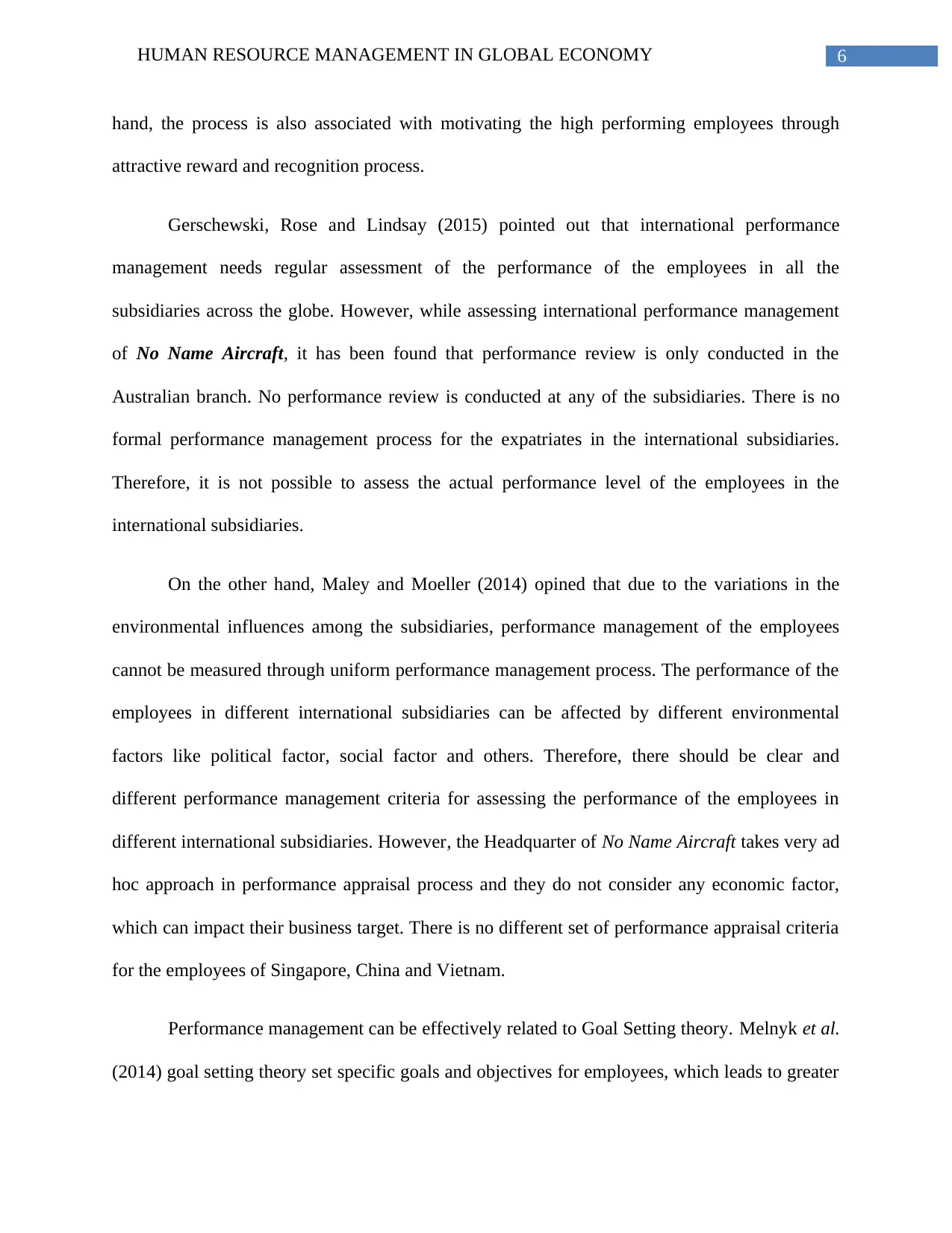
6HUMAN RESOURCE MANAGEMENT IN GLOBAL ECONOMY
hand, the process is also associated with motivating the high performing employees through
attractive reward and recognition process.
Gerschewski, Rose and Lindsay (2015) pointed out that international performance
management needs regular assessment of the performance of the employees in all the
subsidiaries across the globe. However, while assessing international performance management
of No Name Aircraft, it has been found that performance review is only conducted in the
Australian branch. No performance review is conducted at any of the subsidiaries. There is no
formal performance management process for the expatriates in the international subsidiaries.
Therefore, it is not possible to assess the actual performance level of the employees in the
international subsidiaries.
On the other hand, Maley and Moeller (2014) opined that due to the variations in the
environmental influences among the subsidiaries, performance management of the employees
cannot be measured through uniform performance management process. The performance of the
employees in different international subsidiaries can be affected by different environmental
factors like political factor, social factor and others. Therefore, there should be clear and
different performance management criteria for assessing the performance of the employees in
different international subsidiaries. However, the Headquarter of No Name Aircraft takes very ad
hoc approach in performance appraisal process and they do not consider any economic factor,
which can impact their business target. There is no different set of performance appraisal criteria
for the employees of Singapore, China and Vietnam.
Performance management can be effectively related to Goal Setting theory. Melnyk et al.
(2014) goal setting theory set specific goals and objectives for employees, which leads to greater
hand, the process is also associated with motivating the high performing employees through
attractive reward and recognition process.
Gerschewski, Rose and Lindsay (2015) pointed out that international performance
management needs regular assessment of the performance of the employees in all the
subsidiaries across the globe. However, while assessing international performance management
of No Name Aircraft, it has been found that performance review is only conducted in the
Australian branch. No performance review is conducted at any of the subsidiaries. There is no
formal performance management process for the expatriates in the international subsidiaries.
Therefore, it is not possible to assess the actual performance level of the employees in the
international subsidiaries.
On the other hand, Maley and Moeller (2014) opined that due to the variations in the
environmental influences among the subsidiaries, performance management of the employees
cannot be measured through uniform performance management process. The performance of the
employees in different international subsidiaries can be affected by different environmental
factors like political factor, social factor and others. Therefore, there should be clear and
different performance management criteria for assessing the performance of the employees in
different international subsidiaries. However, the Headquarter of No Name Aircraft takes very ad
hoc approach in performance appraisal process and they do not consider any economic factor,
which can impact their business target. There is no different set of performance appraisal criteria
for the employees of Singapore, China and Vietnam.
Performance management can be effectively related to Goal Setting theory. Melnyk et al.
(2014) goal setting theory set specific goals and objectives for employees, which leads to greater
Paraphrase This Document
Need a fresh take? Get an instant paraphrase of this document with our AI Paraphraser
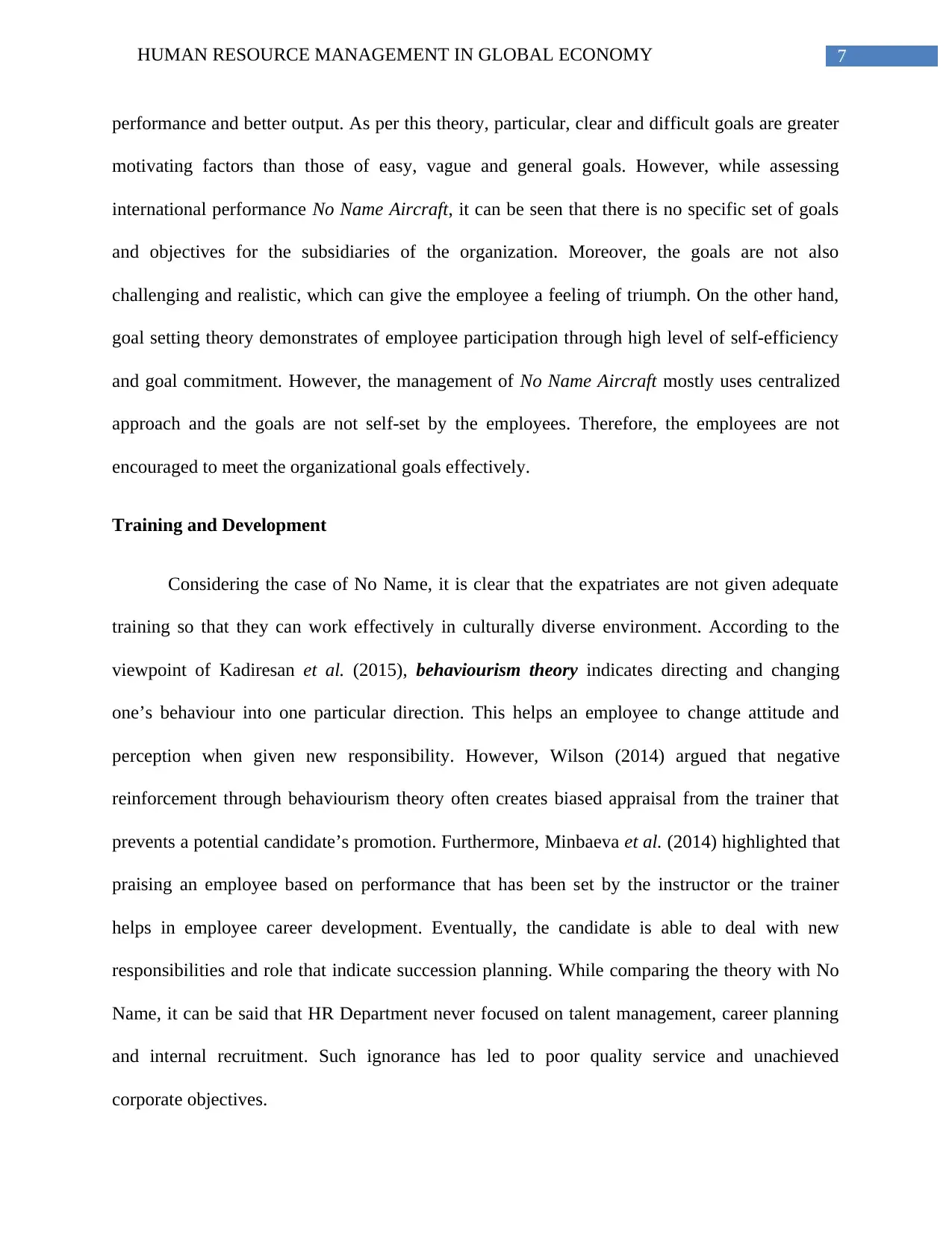
7HUMAN RESOURCE MANAGEMENT IN GLOBAL ECONOMY
performance and better output. As per this theory, particular, clear and difficult goals are greater
motivating factors than those of easy, vague and general goals. However, while assessing
international performance No Name Aircraft, it can be seen that there is no specific set of goals
and objectives for the subsidiaries of the organization. Moreover, the goals are not also
challenging and realistic, which can give the employee a feeling of triumph. On the other hand,
goal setting theory demonstrates of employee participation through high level of self-efficiency
and goal commitment. However, the management of No Name Aircraft mostly uses centralized
approach and the goals are not self-set by the employees. Therefore, the employees are not
encouraged to meet the organizational goals effectively.
Training and Development
Considering the case of No Name, it is clear that the expatriates are not given adequate
training so that they can work effectively in culturally diverse environment. According to the
viewpoint of Kadiresan et al. (2015), behaviourism theory indicates directing and changing
one’s behaviour into one particular direction. This helps an employee to change attitude and
perception when given new responsibility. However, Wilson (2014) argued that negative
reinforcement through behaviourism theory often creates biased appraisal from the trainer that
prevents a potential candidate’s promotion. Furthermore, Minbaeva et al. (2014) highlighted that
praising an employee based on performance that has been set by the instructor or the trainer
helps in employee career development. Eventually, the candidate is able to deal with new
responsibilities and role that indicate succession planning. While comparing the theory with No
Name, it can be said that HR Department never focused on talent management, career planning
and internal recruitment. Such ignorance has led to poor quality service and unachieved
corporate objectives.
performance and better output. As per this theory, particular, clear and difficult goals are greater
motivating factors than those of easy, vague and general goals. However, while assessing
international performance No Name Aircraft, it can be seen that there is no specific set of goals
and objectives for the subsidiaries of the organization. Moreover, the goals are not also
challenging and realistic, which can give the employee a feeling of triumph. On the other hand,
goal setting theory demonstrates of employee participation through high level of self-efficiency
and goal commitment. However, the management of No Name Aircraft mostly uses centralized
approach and the goals are not self-set by the employees. Therefore, the employees are not
encouraged to meet the organizational goals effectively.
Training and Development
Considering the case of No Name, it is clear that the expatriates are not given adequate
training so that they can work effectively in culturally diverse environment. According to the
viewpoint of Kadiresan et al. (2015), behaviourism theory indicates directing and changing
one’s behaviour into one particular direction. This helps an employee to change attitude and
perception when given new responsibility. However, Wilson (2014) argued that negative
reinforcement through behaviourism theory often creates biased appraisal from the trainer that
prevents a potential candidate’s promotion. Furthermore, Minbaeva et al. (2014) highlighted that
praising an employee based on performance that has been set by the instructor or the trainer
helps in employee career development. Eventually, the candidate is able to deal with new
responsibilities and role that indicate succession planning. While comparing the theory with No
Name, it can be said that HR Department never focused on talent management, career planning
and internal recruitment. Such ignorance has led to poor quality service and unachieved
corporate objectives.
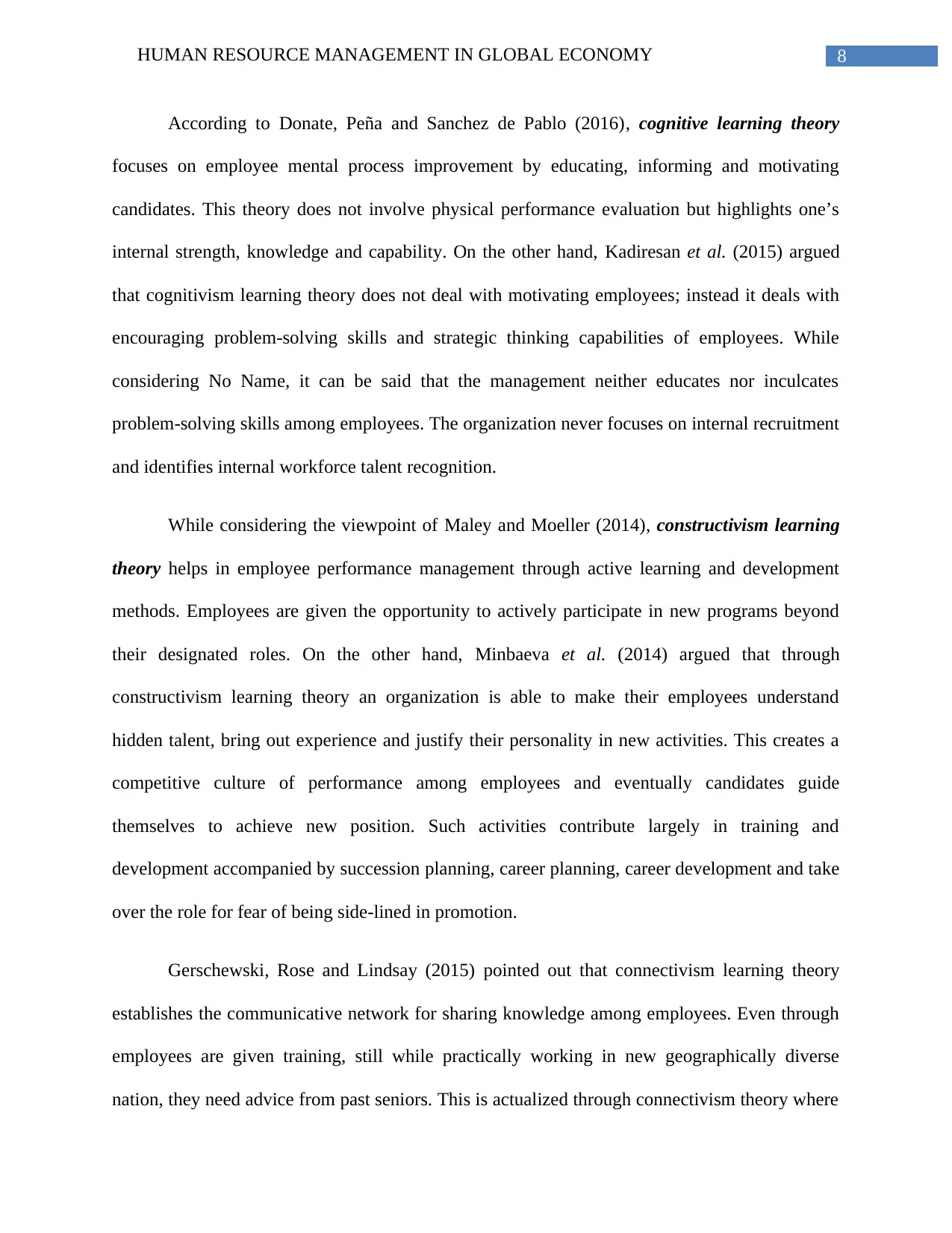
8HUMAN RESOURCE MANAGEMENT IN GLOBAL ECONOMY
According to Donate, Peña and Sanchez de Pablo (2016), cognitive learning theory
focuses on employee mental process improvement by educating, informing and motivating
candidates. This theory does not involve physical performance evaluation but highlights one’s
internal strength, knowledge and capability. On the other hand, Kadiresan et al. (2015) argued
that cognitivism learning theory does not deal with motivating employees; instead it deals with
encouraging problem-solving skills and strategic thinking capabilities of employees. While
considering No Name, it can be said that the management neither educates nor inculcates
problem-solving skills among employees. The organization never focuses on internal recruitment
and identifies internal workforce talent recognition.
While considering the viewpoint of Maley and Moeller (2014), constructivism learning
theory helps in employee performance management through active learning and development
methods. Employees are given the opportunity to actively participate in new programs beyond
their designated roles. On the other hand, Minbaeva et al. (2014) argued that through
constructivism learning theory an organization is able to make their employees understand
hidden talent, bring out experience and justify their personality in new activities. This creates a
competitive culture of performance among employees and eventually candidates guide
themselves to achieve new position. Such activities contribute largely in training and
development accompanied by succession planning, career planning, career development and take
over the role for fear of being side-lined in promotion.
Gerschewski, Rose and Lindsay (2015) pointed out that connectivism learning theory
establishes the communicative network for sharing knowledge among employees. Even through
employees are given training, still while practically working in new geographically diverse
nation, they need advice from past seniors. This is actualized through connectivism theory where
According to Donate, Peña and Sanchez de Pablo (2016), cognitive learning theory
focuses on employee mental process improvement by educating, informing and motivating
candidates. This theory does not involve physical performance evaluation but highlights one’s
internal strength, knowledge and capability. On the other hand, Kadiresan et al. (2015) argued
that cognitivism learning theory does not deal with motivating employees; instead it deals with
encouraging problem-solving skills and strategic thinking capabilities of employees. While
considering No Name, it can be said that the management neither educates nor inculcates
problem-solving skills among employees. The organization never focuses on internal recruitment
and identifies internal workforce talent recognition.
While considering the viewpoint of Maley and Moeller (2014), constructivism learning
theory helps in employee performance management through active learning and development
methods. Employees are given the opportunity to actively participate in new programs beyond
their designated roles. On the other hand, Minbaeva et al. (2014) argued that through
constructivism learning theory an organization is able to make their employees understand
hidden talent, bring out experience and justify their personality in new activities. This creates a
competitive culture of performance among employees and eventually candidates guide
themselves to achieve new position. Such activities contribute largely in training and
development accompanied by succession planning, career planning, career development and take
over the role for fear of being side-lined in promotion.
Gerschewski, Rose and Lindsay (2015) pointed out that connectivism learning theory
establishes the communicative network for sharing knowledge among employees. Even through
employees are given training, still while practically working in new geographically diverse
nation, they need advice from past seniors. This is actualized through connectivism theory where
⊘ This is a preview!⊘
Do you want full access?
Subscribe today to unlock all pages.

Trusted by 1+ million students worldwide
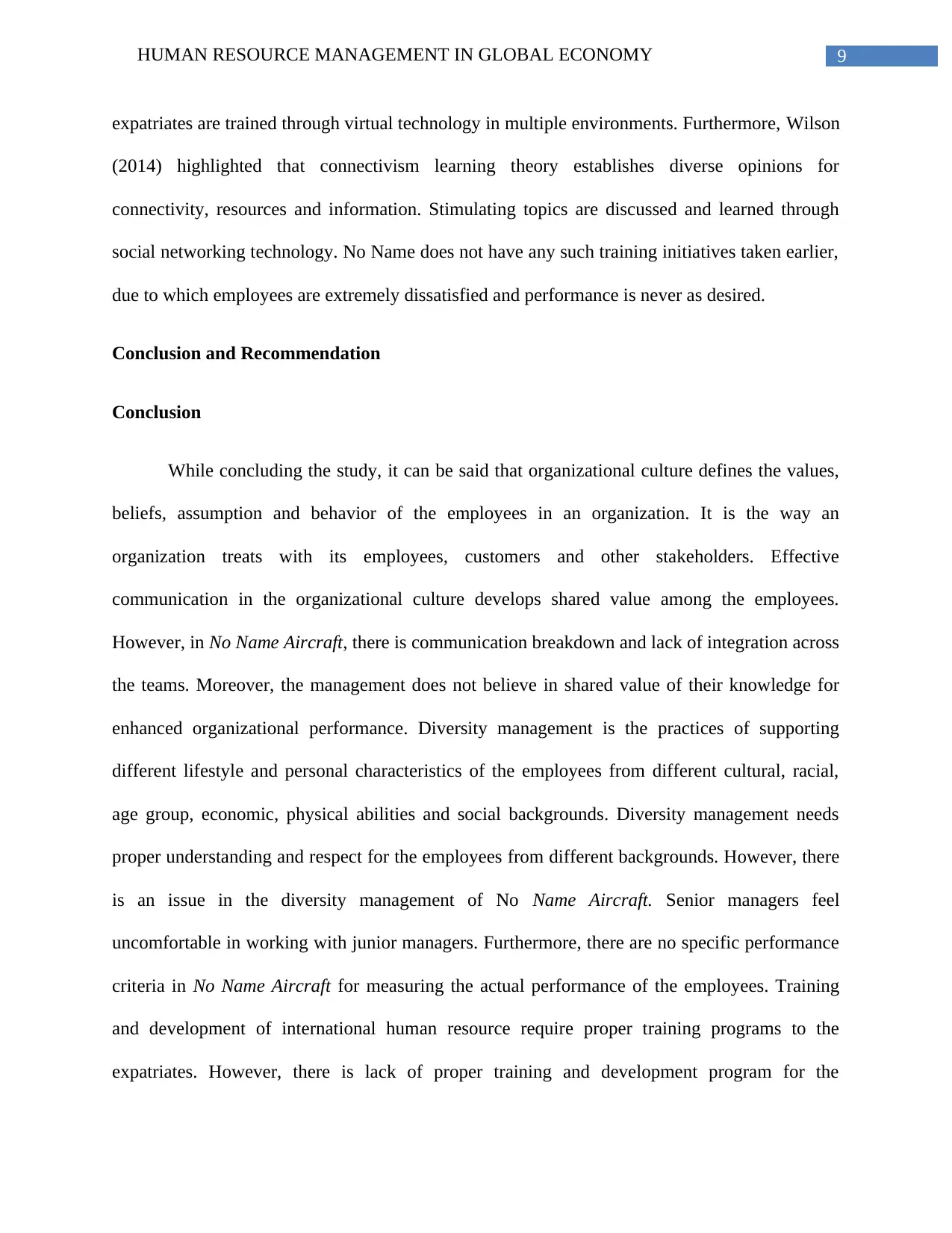
9HUMAN RESOURCE MANAGEMENT IN GLOBAL ECONOMY
expatriates are trained through virtual technology in multiple environments. Furthermore, Wilson
(2014) highlighted that connectivism learning theory establishes diverse opinions for
connectivity, resources and information. Stimulating topics are discussed and learned through
social networking technology. No Name does not have any such training initiatives taken earlier,
due to which employees are extremely dissatisfied and performance is never as desired.
Conclusion and Recommendation
Conclusion
While concluding the study, it can be said that organizational culture defines the values,
beliefs, assumption and behavior of the employees in an organization. It is the way an
organization treats with its employees, customers and other stakeholders. Effective
communication in the organizational culture develops shared value among the employees.
However, in No Name Aircraft, there is communication breakdown and lack of integration across
the teams. Moreover, the management does not believe in shared value of their knowledge for
enhanced organizational performance. Diversity management is the practices of supporting
different lifestyle and personal characteristics of the employees from different cultural, racial,
age group, economic, physical abilities and social backgrounds. Diversity management needs
proper understanding and respect for the employees from different backgrounds. However, there
is an issue in the diversity management of No Name Aircraft. Senior managers feel
uncomfortable in working with junior managers. Furthermore, there are no specific performance
criteria in No Name Aircraft for measuring the actual performance of the employees. Training
and development of international human resource require proper training programs to the
expatriates. However, there is lack of proper training and development program for the
expatriates are trained through virtual technology in multiple environments. Furthermore, Wilson
(2014) highlighted that connectivism learning theory establishes diverse opinions for
connectivity, resources and information. Stimulating topics are discussed and learned through
social networking technology. No Name does not have any such training initiatives taken earlier,
due to which employees are extremely dissatisfied and performance is never as desired.
Conclusion and Recommendation
Conclusion
While concluding the study, it can be said that organizational culture defines the values,
beliefs, assumption and behavior of the employees in an organization. It is the way an
organization treats with its employees, customers and other stakeholders. Effective
communication in the organizational culture develops shared value among the employees.
However, in No Name Aircraft, there is communication breakdown and lack of integration across
the teams. Moreover, the management does not believe in shared value of their knowledge for
enhanced organizational performance. Diversity management is the practices of supporting
different lifestyle and personal characteristics of the employees from different cultural, racial,
age group, economic, physical abilities and social backgrounds. Diversity management needs
proper understanding and respect for the employees from different backgrounds. However, there
is an issue in the diversity management of No Name Aircraft. Senior managers feel
uncomfortable in working with junior managers. Furthermore, there are no specific performance
criteria in No Name Aircraft for measuring the actual performance of the employees. Training
and development of international human resource require proper training programs to the
expatriates. However, there is lack of proper training and development program for the
Paraphrase This Document
Need a fresh take? Get an instant paraphrase of this document with our AI Paraphraser
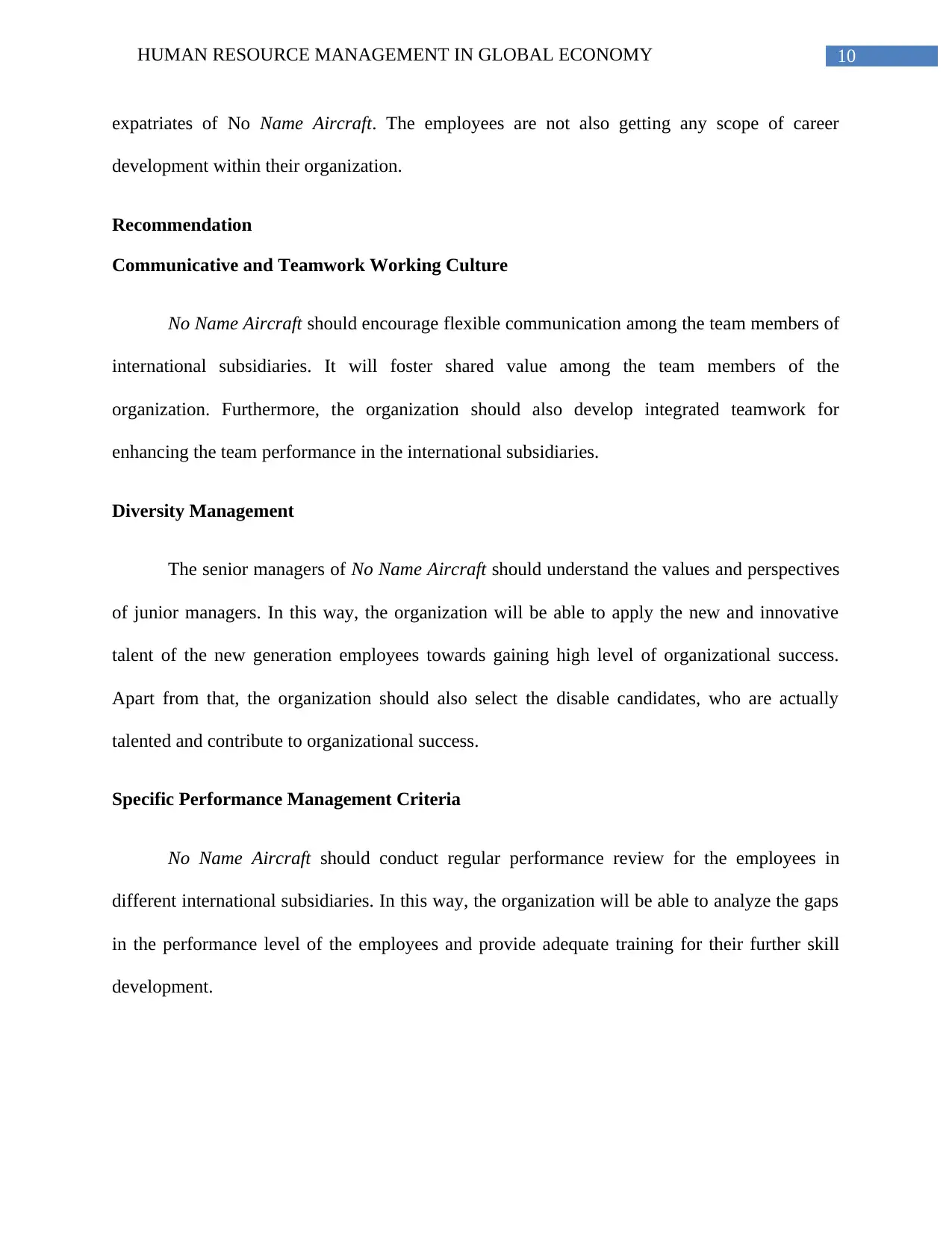
10HUMAN RESOURCE MANAGEMENT IN GLOBAL ECONOMY
expatriates of No Name Aircraft. The employees are not also getting any scope of career
development within their organization.
Recommendation
Communicative and Teamwork Working Culture
No Name Aircraft should encourage flexible communication among the team members of
international subsidiaries. It will foster shared value among the team members of the
organization. Furthermore, the organization should also develop integrated teamwork for
enhancing the team performance in the international subsidiaries.
Diversity Management
The senior managers of No Name Aircraft should understand the values and perspectives
of junior managers. In this way, the organization will be able to apply the new and innovative
talent of the new generation employees towards gaining high level of organizational success.
Apart from that, the organization should also select the disable candidates, who are actually
talented and contribute to organizational success.
Specific Performance Management Criteria
No Name Aircraft should conduct regular performance review for the employees in
different international subsidiaries. In this way, the organization will be able to analyze the gaps
in the performance level of the employees and provide adequate training for their further skill
development.
expatriates of No Name Aircraft. The employees are not also getting any scope of career
development within their organization.
Recommendation
Communicative and Teamwork Working Culture
No Name Aircraft should encourage flexible communication among the team members of
international subsidiaries. It will foster shared value among the team members of the
organization. Furthermore, the organization should also develop integrated teamwork for
enhancing the team performance in the international subsidiaries.
Diversity Management
The senior managers of No Name Aircraft should understand the values and perspectives
of junior managers. In this way, the organization will be able to apply the new and innovative
talent of the new generation employees towards gaining high level of organizational success.
Apart from that, the organization should also select the disable candidates, who are actually
talented and contribute to organizational success.
Specific Performance Management Criteria
No Name Aircraft should conduct regular performance review for the employees in
different international subsidiaries. In this way, the organization will be able to analyze the gaps
in the performance level of the employees and provide adequate training for their further skill
development.
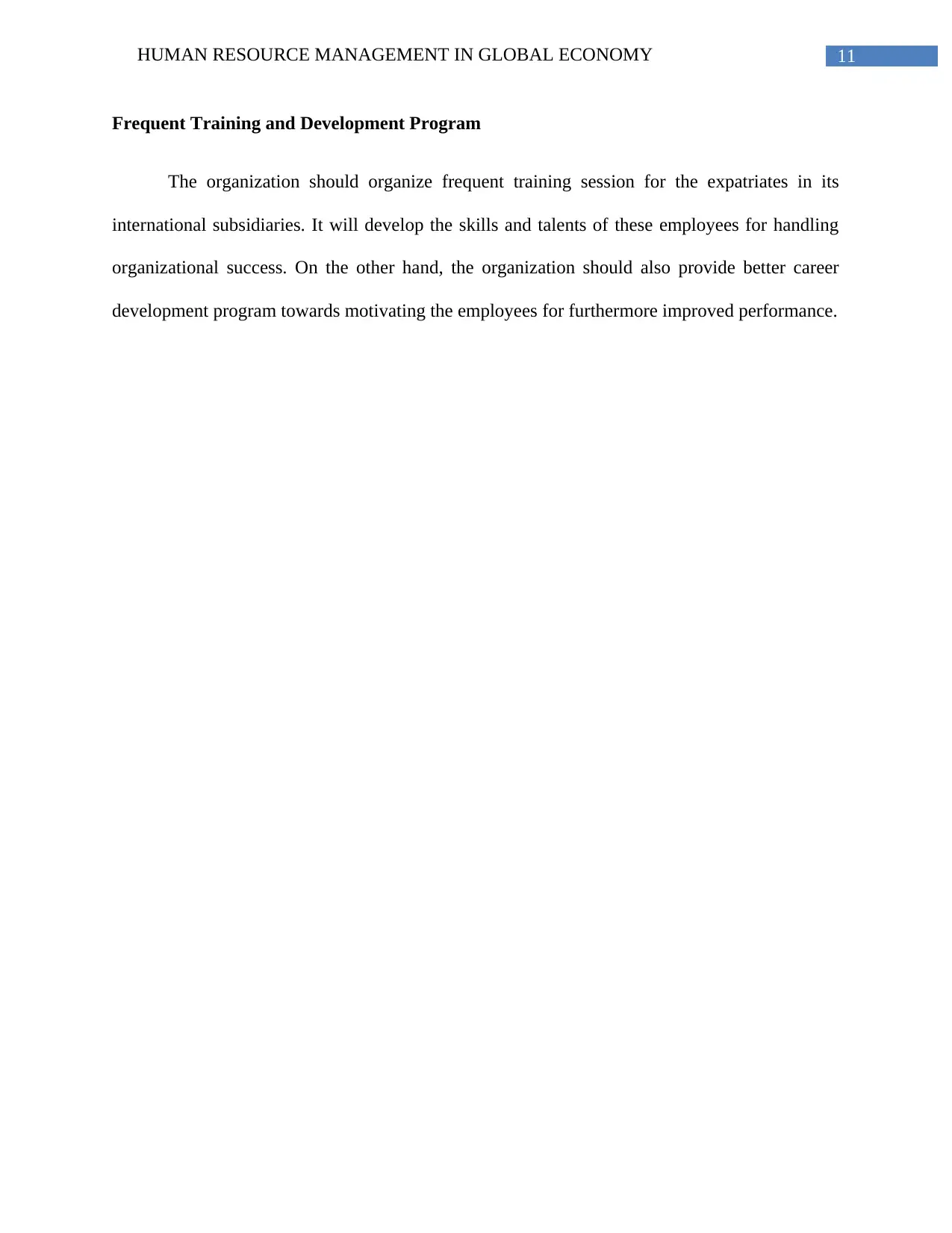
11HUMAN RESOURCE MANAGEMENT IN GLOBAL ECONOMY
Frequent Training and Development Program
The organization should organize frequent training session for the expatriates in its
international subsidiaries. It will develop the skills and talents of these employees for handling
organizational success. On the other hand, the organization should also provide better career
development program towards motivating the employees for furthermore improved performance.
Frequent Training and Development Program
The organization should organize frequent training session for the expatriates in its
international subsidiaries. It will develop the skills and talents of these employees for handling
organizational success. On the other hand, the organization should also provide better career
development program towards motivating the employees for furthermore improved performance.
⊘ This is a preview!⊘
Do you want full access?
Subscribe today to unlock all pages.

Trusted by 1+ million students worldwide
1 out of 15
Related Documents
Your All-in-One AI-Powered Toolkit for Academic Success.
+13062052269
info@desklib.com
Available 24*7 on WhatsApp / Email
![[object Object]](/_next/static/media/star-bottom.7253800d.svg)
Unlock your academic potential
Copyright © 2020–2025 A2Z Services. All Rights Reserved. Developed and managed by ZUCOL.




